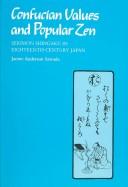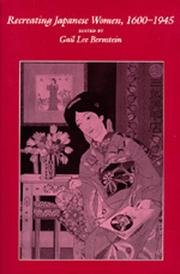| Listing 1 - 4 of 4 |
Sort by
|
Book
Year: 1971 Publisher: Tōkyō : Iwanami Shoten,
Abstract | Keywords | Export | Availability | Bookmark
 Loading...
Loading...Choose an application
- Reference Manager
- EndNote
- RefWorks (Direct export to RefWorks)

ISBN: 9780824814144 0824814142 Year: 1993 Publisher: Honolulu University of Hawaii Press
Abstract | Keywords | Export | Availability | Bookmark
 Loading...
Loading...Choose an application
- Reference Manager
- EndNote
- RefWorks (Direct export to RefWorks)
"Although East Asian religion is commonly characterized as "syncretic," the historical interaction of Buddhist, Confucian, and other traditions is often neglected by scholars of mainstream religious thought. In this thought-provoking study, Janine Sawada moves beyond conventional approaches to the history of Japanese religion by analyzing the ways in which Neo-Confucianism and Zen formed a popular synthesis in early modern Japan. She shows how Shingaku, a teaching founded by merchant Ishida Baigan, blossomed after his death into a widespread religious movement that selectively combined ideas and practices from these traditions. Drawing on new research into original Shingaku sources, Sawada challenges the view that the teaching was a facile "merchant ethic" by illuminating the importance of Shingaku mystical experience and its intimate relation to moral cultivation in the program developed by Baigan's successor, Teshima Toan."--BOOK JACKET. "This book also suggests the need for an approach to the history of Japanese education that accounts for the informal transmission of ideas as well as institutional schooling. Shingaku contributed to the development of Japanese education by effectively disseminating moral and religious knowledge on a large scale to the less-educated sectors of Tokugawa society. Sawada interprets the popularity of the movement as part of a general trend in early modern Japan in which ordinary people sought forms of learning that could be pursued in the context of daily life."--BOOK JACKET.
Shingaku --- Confucianism --- J1650 --- J1008.60 --- Religions --- Sekimon Shingaku --- Ethics --- History --- Japan: Philosophy -- ethics --- Japan: Philosophy -- history -- Kinsei, Edo, Tokugawa period, early modern (1600-1867) --- Japan --- 18th century --- Shingaku. --- Confucianism - Japan - History - 18th century.
Book
ISBN: 0691221561 Year: 1988 Publisher: Princeton [u.a.] Princeton Univ. Pr.
Abstract | Keywords | Export | Availability | Bookmark
 Loading...
Loading...Choose an application
- Reference Manager
- EndNote
- RefWorks (Direct export to RefWorks)
The description for this book, Kurozumikyo and the New Religions of Japan, will be forthcoming.
Kurozumikyō (Religious organization) --- Akagi Tadaharu. --- Amaterasu Ōmikami. --- Buddhism. --- Great Purification Prayer. --- Grounds Purification. --- House Purification. --- Ise Shrines. --- Ishida Baigan. --- Kibigaku. --- Konkōkyō. --- Korean minority. --- Kurozumi Munetada. --- Laymen's Meeting. --- Neo-Confucian thought. --- Reiyūkai Kyōdan. --- Risshōkōseikai. --- Shingaku. --- Shrine Shintō. --- Sixth Patriarch. --- Tenrikyō. --- Women's Group. --- confraternity. --- core values. --- counseling. --- divination. --- established religions. --- funeral. --- gratitude. --- healing. --- karma. --- laity, lay centrality. --- majinai. --- mizuko kuyo. --- national learning. --- new religions. --- ogamiya. --- pilgrimage. --- pollution. --- preaching. --- proselytization. --- purification. --- purity. --- self-cultivation. --- sincerity. --- small soul. --- village headmen. --- women. --- world view. --- yōki. --- Ōi Church. --- Ōmotokyō.

ISBN: 0520910184 1282355708 9786612355707 0585104905 9780520910188 9780585104904 0520070151 9780520070158 0520070178 9780520070172 Year: 1991 Publisher: Berkeley University of California Press
Abstract | Keywords | Export | Availability | Bookmark
 Loading...
Loading...Choose an application
- Reference Manager
- EndNote
- RefWorks (Direct export to RefWorks)
In thirteen wide-ranging essays, scholars and students of Asian and women's studies will find a vivid exploration of how female roles and feminine identity have evolved over 350 years, from the Tokugawa era to the end of World War II. Starting from the premise that gender is not a biological given, but is socially constructed and culturally transmitted, the authors describe the forces of change in the construction of female gender and explore the gap between the ideal of womanhood and the reality of Japanese women's lives. Most of all, the contributors speak to the diversity that has characterized women's experience in Japan. This is an imaginative, pioneering work, offering an interdisciplinary approach that will encourage a reconsideration of the paradigms of women's history, hitherto rooted in the Western experience.
Women --- Feminism --- Employment --- History. --- #SBIB:316.346H20 --- #SBIB:39A11 --- #SBIB:39A75 --- #SBIB:95G --- J4176.80 --- J4353 --- Human females --- Wimmin --- Woman --- Womon --- Womyn --- Females --- Human beings --- Femininity --- History --- Employment&delete& --- Positie van de vrouw in de samenleving: algemeen --- Antropologie : socio-politieke structuren en relaties --- Etnografie: Azië --- Geschiedenis van Azië (inclusief Arabische wereld, Nabije Oosten) --- Japan: Sociology and anthropology -- gender roles, women, feminism -- history --- Japan: Economy and industry -- labor and employment -- women --- Femmes --- Féminisme --- Histoire --- Travail --- Japan --- Féminisme --- Japon --- agriculture. --- artisan. --- bakufu. --- class. --- division of labor. --- domesticity. --- femininity. --- feminism. --- gender hierarchy. --- gender roles. --- gender studies. --- gender. --- gendered labor. --- handicrafts. --- household chores. --- household labor. --- japan. --- japanese women. --- meiji restoration. --- merchants. --- misogyny. --- onnagata. --- onnarashisa. --- otokorashisa. --- patriarchy. --- peasants. --- post war. --- preindustrial society. --- samurai. --- sexuality. --- shingaku. --- status. --- tokugawa. --- wealth. --- womanhood. --- women and labor. --- women in history. --- women in the workforce. --- womens studies. --- womens work. --- working women.
| Listing 1 - 4 of 4 |
Sort by
|

 Search
Search Feedback
Feedback About UniCat
About UniCat  Help
Help News
News